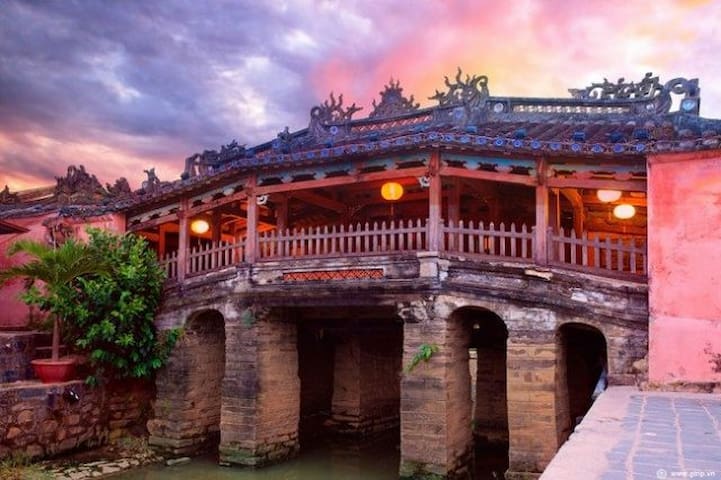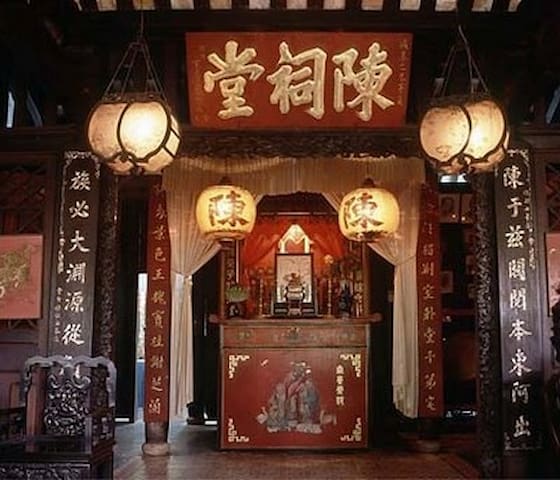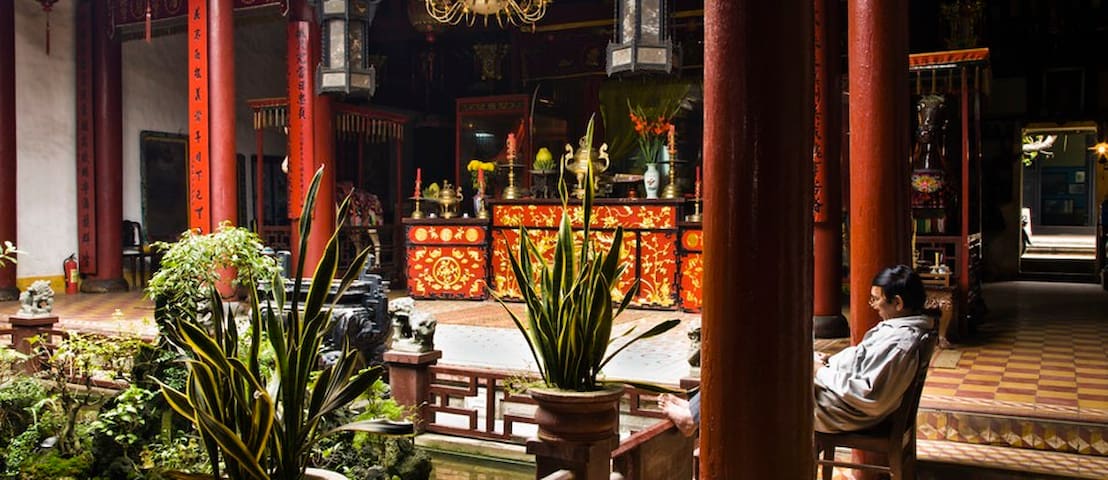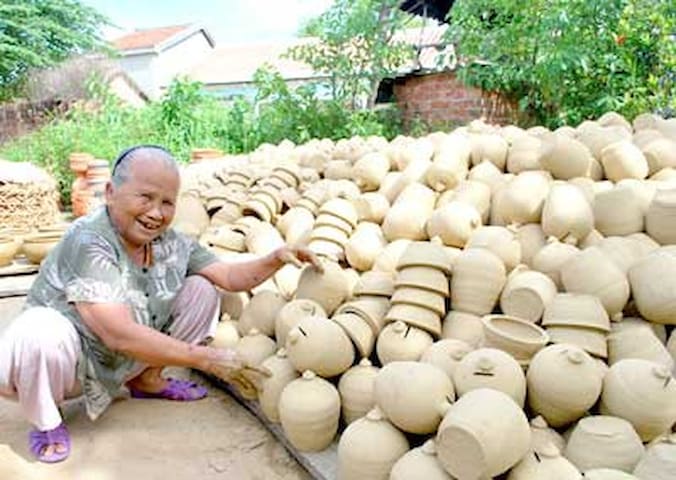Sightseeing
The bridge was opened by Nguyen Phuc Chu Lord in 1719 who carved three Chinese symbols above the door in commemoration. The bridge also features the sculptures of two dogs and two monkeys representing the Chinese years in which many Japanese Emperors were born along with the fact that the building of the bridge began in the year of the dog and was completed in the year of the monkey.
The Japanese Covered Bridge underwent renovation work in 1986 which saw the restoration of the arch that was once flattened to make way for cars. Today, the bridge stands as a symbol of Hoi An and remains as aesthetically pleasing as it was when it first opened
The bridge was opened by Nguyen Phuc Chu Lord in 1719 who carved three Chinese symbols above the door in commemoration. The bridge also features the sculptures of two dogs and two monkeys representing the Chinese years in which many Japanese Emperors were born along with the fact that the building of the bridge began in the year of the dog and was completed in the year of the monkey.
The Japanese Covered Bridge underwent renovation work in 1986 which saw the restoration of the arch that was once flattened to make way for cars. Today, the bridge stands as a symbol of Hoi An and remains as aesthetically pleasing as it was when it first opened.
91 当地人推荐
日本式有顶桥
186 Trần PhúThe bridge was opened by Nguyen Phuc Chu Lord in 1719 who carved three Chinese symbols above the door in commemoration. The bridge also features the sculptures of two dogs and two monkeys representing the Chinese years in which many Japanese Emperors were born along with the fact that the building of the bridge began in the year of the dog and was completed in the year of the monkey.
The Japanese Covered Bridge underwent renovation work in 1986 which saw the restoration of the arch that was once flattened to make way for cars. Today, the bridge stands as a symbol of Hoi An and remains as aesthetically pleasing as it was when it first opened.
Sitting amidst a 1500m2-garden of ornamental plants, flowers, fruit trees and century-old plants, with a gate and high surrounding walls is a combination of Chinese, Japanese and Vietnamese architecture, which has remained almost the same as two centuries ago. Made of precious wood and pan-tiles-covered roof, the house has become well-known for its Asian style of architecture: one main part for worshipping, and one supplemental part which houses the leader of family and his guests. The house and the garden were built in harmony following strictly the rules of Feng Shui. The drawing room of the chapel has separate entries for men and women: the left is for men and the right is only for women, according to old belief. There is another door in the center of the room, used for festivals such as Tet, which is said to be the door for souls of the ancestors to enter the house.
Every year, the Tran Family Chapel is still the gathering place for all members of the family to meet and express their thankfulness to their ancestors. Also, parents in the family would educate their children about the clan’s traditions
For tourists who are in love with the unique and historical atmosphere of ancient sites, a visit to the Tran Family Chapel will be one of the most remarkable parts of Hoi An experience, as history and tradition are not only imbued in the relics of Tran Tu Nhac like a sword and a seal, but also in every corner of the house: in old family pictures, in the cozy atmostphere of the family gatherings.
The house is located in the center of the old town hence it’s easy getting there, especially by bike and on foot
TIPS:
The site opens from Mon to Sun, from: 08.30AM to 06.00PM. Admission fee is different for Vietnamese and foreigners: VND 40,000/3 sites (Vietnamese) and VND 75,000/6 sites (foreigners). Note that ticket in Hoi An is a little bit different from other places. One ticket will allow access to: all the old streets of the Heritage Town, one of the four museums, one of the four 'old houses', one of the three 'assembly halls', the handicraft workshop and traditional music concert, and either the Japanese Bridge or the Quan Cong Temple.
15 当地人推荐
Tran Family Chapel
21 Lê LợiSitting amidst a 1500m2-garden of ornamental plants, flowers, fruit trees and century-old plants, with a gate and high surrounding walls is a combination of Chinese, Japanese and Vietnamese architecture, which has remained almost the same as two centuries ago. Made of precious wood and pan-tiles-covered roof, the house has become well-known for its Asian style of architecture: one main part for worshipping, and one supplemental part which houses the leader of family and his guests. The house and the garden were built in harmony following strictly the rules of Feng Shui. The drawing room of the chapel has separate entries for men and women: the left is for men and the right is only for women, according to old belief. There is another door in the center of the room, used for festivals such as Tet, which is said to be the door for souls of the ancestors to enter the house.
Every year, the Tran Family Chapel is still the gathering place for all members of the family to meet and express their thankfulness to their ancestors. Also, parents in the family would educate their children about the clan’s traditions
For tourists who are in love with the unique and historical atmosphere of ancient sites, a visit to the Tran Family Chapel will be one of the most remarkable parts of Hoi An experience, as history and tradition are not only imbued in the relics of Tran Tu Nhac like a sword and a seal, but also in every corner of the house: in old family pictures, in the cozy atmostphere of the family gatherings.
The house is located in the center of the old town hence it’s easy getting there, especially by bike and on foot
TIPS:
The site opens from Mon to Sun, from: 08.30AM to 06.00PM. Admission fee is different for Vietnamese and foreigners: VND 40,000/3 sites (Vietnamese) and VND 75,000/6 sites (foreigners). Note that ticket in Hoi An is a little bit different from other places. One ticket will allow access to: all the old streets of the Heritage Town, one of the four museums, one of the four 'old houses', one of the three 'assembly halls', the handicraft workshop and traditional music concert, and either the Japanese Bridge or the Quan Cong Temple.
On the left of Quan Cong is a statue of General Chau Xuong, one of his guardians, striking a tough-guy pose. On the right is the rather plump administrative mandarin Quan Binh. The life-size white horse recalls a mount ridden by Quan Cong.
Check out the carp-shaped rain spouts on the roof surrounding the courtyard. The carp is a symbol of patience in Chinese mythology and is popular in Hoi An.
Shoes should be removed when mounting the platform in front of the statue of Quan Cong.
25 当地人推荐
Quan Kong Temple
24 Trần PhúOn the left of Quan Cong is a statue of General Chau Xuong, one of his guardians, striking a tough-guy pose. On the right is the rather plump administrative mandarin Quan Binh. The life-size white horse recalls a mount ridden by Quan Cong.
Check out the carp-shaped rain spouts on the roof surrounding the courtyard. The carp is a symbol of patience in Chinese mythology and is popular in Hoi An.
Shoes should be removed when mounting the platform in front of the statue of Quan Cong.
The tradition dated back to the time when the Nguyen Dynasty of Hue invited craftsmen f-rom the Thanh Ha Pottery Village to fashion some decorative as well as useful articles for the palace. This one event gained them sufficient renown to last them a lifetime. Henceforth, the village began a Mandrain system of grading craftsmen according to their talent. The most talented held the ninth position. The pottery at the Thanh Ha Pottery Village in Hoi An are all manually crafted and are exported world over. The techniques that they use are unique f-rom those prevalent in other provinces. The Thanh Ha Pottery Village in Hoi An crafts decorative articles along with useful items like cups, jars, bowls and pots. The flower pots made here are particularly sought after.
The Thanh Ha Pottery Village in Hoi An used clay mixing techniques, burning and baking time and heat modulations to bring out different colors like pink, pinkish-yellow, red, light brown and ink-black in the wares. The craftsmen also modulate all these aspects to achieve immense durability in their products. Aside of the regular articles, the Thanh Ha Pottery Village in Hoi An is also renowned for its bricks and tiles of various shapes and sizes. In fact its bricks and tiles are sourced out to the entire local as well as many foreign regions. It is the most trusted name for contractors engaged in tasks of renovation.
37 当地人推荐
Thanh Ha pottery
Đường Phạm PhánThe tradition dated back to the time when the Nguyen Dynasty of Hue invited craftsmen f-rom the Thanh Ha Pottery Village to fashion some decorative as well as useful articles for the palace. This one event gained them sufficient renown to last them a lifetime. Henceforth, the village began a Mandrain system of grading craftsmen according to their talent. The most talented held the ninth position. The pottery at the Thanh Ha Pottery Village in Hoi An are all manually crafted and are exported world over. The techniques that they use are unique f-rom those prevalent in other provinces. The Thanh Ha Pottery Village in Hoi An crafts decorative articles along with useful items like cups, jars, bowls and pots. The flower pots made here are particularly sought after.
The Thanh Ha Pottery Village in Hoi An used clay mixing techniques, burning and baking time and heat modulations to bring out different colors like pink, pinkish-yellow, red, light brown and ink-black in the wares. The craftsmen also modulate all these aspects to achieve immense durability in their products. Aside of the regular articles, the Thanh Ha Pottery Village in Hoi An is also renowned for its bricks and tiles of various shapes and sizes. In fact its bricks and tiles are sourced out to the entire local as well as many foreign regions. It is the most trusted name for contractors engaged in tasks of renovation.
Like many historic sites around the world, My Son was destroyed by time and wars and after lying neglected for a long time it was rediscovered and renovated by the French in 1898. Sadly the most recent war did great damage to the complex as the Americans bombed this area knowing that the Viet Cong used it as a hiding place, mistakenly thinking that the enemy would not touch a holy site.
However, the majority of the central complex managed to survive the bombs and parts of the ruins have now been rebuilt. Overall, this Hindu sanctuary reminds visitors of other similar sites in Southeast Asia including the great Angkor Wat in Cambodia. A must-visit for those who appreciate history.
Opening Hours: All year round. The best time to visit is early in the morning before it gets too hot and when it is not too busy
Location: In a small valley in Duy Tan Commune, Duy Xuyen District of Quang Nam Province (about 70km southwest of Danang and 40km from Hoi An)
53 当地人推荐
世界文化遗产美山
Đường vào Mỹ SơnLike many historic sites around the world, My Son was destroyed by time and wars and after lying neglected for a long time it was rediscovered and renovated by the French in 1898. Sadly the most recent war did great damage to the complex as the Americans bombed this area knowing that the Viet Cong used it as a hiding place, mistakenly thinking that the enemy would not touch a holy site.
However, the majority of the central complex managed to survive the bombs and parts of the ruins have now been rebuilt. Overall, this Hindu sanctuary reminds visitors of other similar sites in Southeast Asia including the great Angkor Wat in Cambodia. A must-visit for those who appreciate history.
Opening Hours: All year round. The best time to visit is early in the morning before it gets too hot and when it is not too busy
Location: In a small valley in Duy Tan Commune, Duy Xuyen District of Quang Nam Province (about 70km southwest of Danang and 40km from Hoi An)





